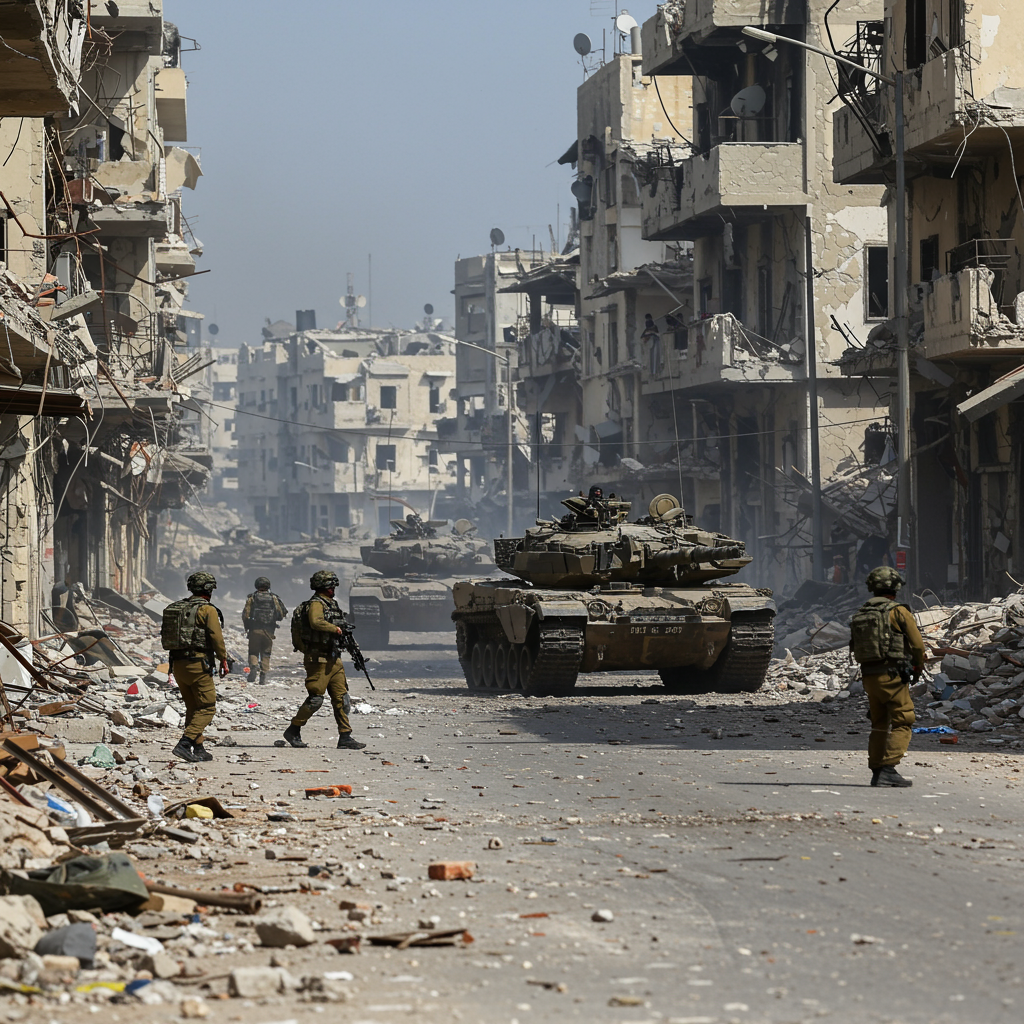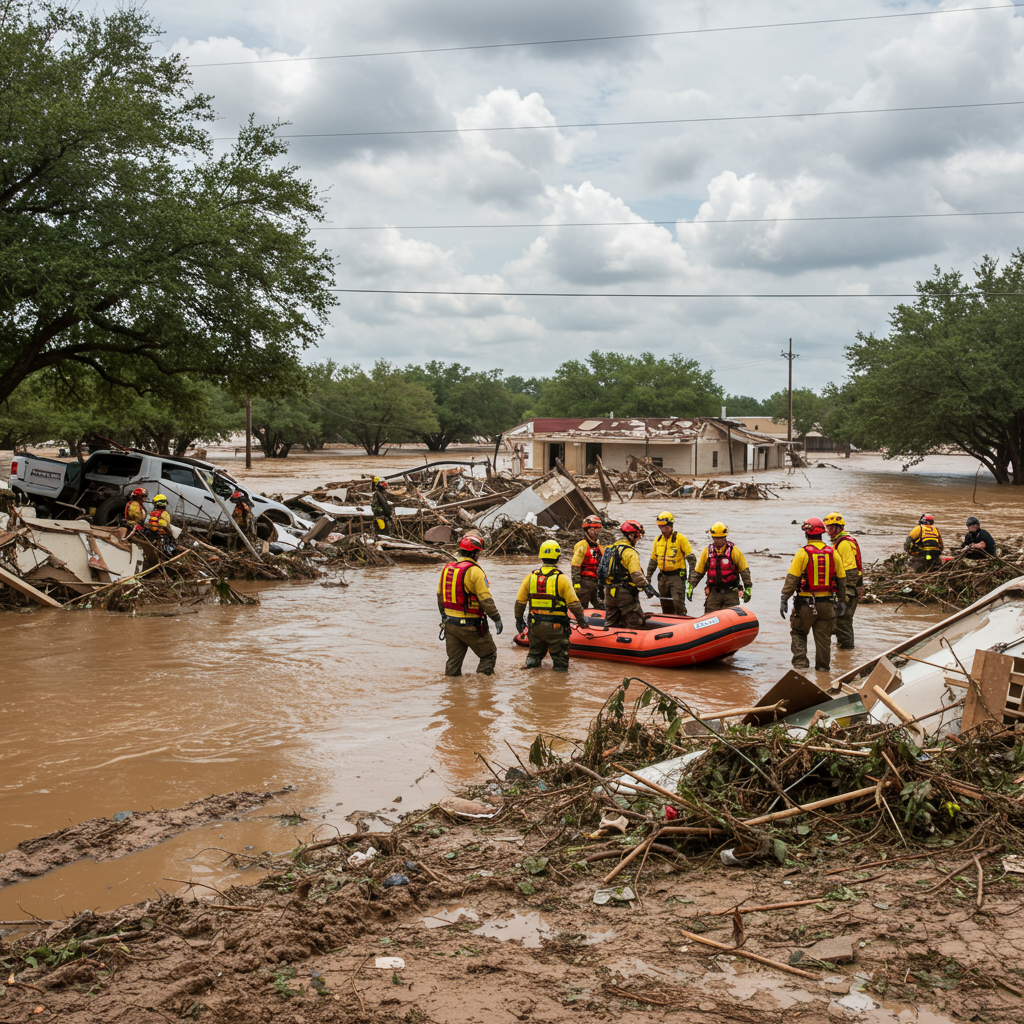The Israeli military has launched an expanded ground offensive in Gaza City, escalating the already dire conflict under the code name “Operation Gideon’s Chariots II.” This intensified operation aims to dismantle Hamas’s infrastructure, defeat its forces, and create conditions for the release of hostages held in the besieged Palestinian enclave. The offensive follows a night of relentless bombardment, sending troops and tanks deep into Gaza City’s outskirts and profoundly worsening a catastrophic humanitarian crisis.
The Intensifying Ground Offensive: “Gideon’s Chariots II”
Israel’s military operation in Gaza City marks a significant phase in the ongoing conflict. With a declared objective to “overwhelm” and “crush” Hamas’s capabilities, the Israeli Defense Forces (IDF) have committed substantial resources. This includes the call-up of 60,000 reservists and the deployment of three combat divisions (98, 162, and 36). IDF Chief of Staff Lt. Gen. Eyal Zamir underscored its “decisive importance” for the war’s progression, identifying Gaza City as a “vital area for Hamas.”
Strategic Objectives and Military Scale
The IDF’s stated goals are clear: decisively defeat Hamas’s Gaza City brigade, eradicate its “terrorist infrastructure,” and secure the return of all hostages. Over the past week, the military claims to have struck more than 850 “terror targets” and “hundreds of terrorists.” Defense Minister Israel Katz affirmed the resolve, declaring “Gaza is burning” and vowing “not to relent… until the mission is completed.” Reports suggest the IDF believes 2,000 to 3,000 Hamas militants remain in the city, relying on tunnel networks and guerrilla tactics. Israeli officials estimate taking control of Gaza City could span months, with clearing its complex infrastructure taking even longer. By the operation’s conclusion, Israel reportedly intends to control most of the Gaza Strip, excluding a large coastal area.
Unprecedented Humanitarian Crisis and Mass Displacement
The ground invasion has amplified an already severe humanitarian catastrophe. Thousands of Palestinians are fleeing northern Gaza, transforming coastal roads into congested escape routes. An estimated one million residents lived in the Gaza City region before evacuation warnings. Recent days have seen over 70,000 people flee south, contributing to approximately 150,000 displaced in the past month.
Fleeing the Conflict Zone
The mass exodus paints a grim picture. Families, often with few belongings, struggle to find safe passage. Transport costs have soared, with some residents reporting fees around $1,000 for truck transport south, even amidst widespread starvation. Gaza City faces dire famine conditions, malnutrition, and dehydration, with the Ministry of Health reporting 428 famine-related deaths, including 146 children. Many displaced individuals are forced to pitch tents in unsanitary conditions due to lack of viable shelter. Disturbingly, some are reportedly returning to Gaza City despite the offensive, finding conditions in southern camps equally desperate or worse.
Devastating Impact on Civilians and Infrastructure
The toll on civilian life is immense. Palestinian health officials report nearly 65,000 Palestinians killed by Israeli attacks, with at least half being women and children. Gaza’s Al-Shifa Hospital director described “a very tough night,” receiving 96 bodies in a single day, 84 from Gaza City alone. Medical staff face overwhelming challenges due to critical resource shortages. UNICEF condemned the forced displacement as “inhumane,” highlighting the profound trauma inflicted on Gaza’s half a million children. Satellite imagery confirms extensive destruction, showing IDF vehicles across northern Gaza City and widespread damage to buildings. The Palestinian Foreign Ministry decried the offensive as “deliberate targeting of civilians,” predicting Gaza City would become an “uninhabitable mass graveyard.”
International Condemnation and Accusations of Genocide
The expanded ground operation in Gaza City has sparked widespread international condemnation and severe legal accusations. An independent United Nations commission delivered a significant ruling. It concluded that Israel is committing genocide in Gaza, applying a high legal standard.
UN Commission Findings
The UN commission found “genocidal intent” based on statements by Israeli authorities and the consistent pattern of conduct. It specifically identified “four of the five genocidal acts” defined by the 1948 Genocide Convention. The report named Israeli Prime Minister Benjamin Netanyahu, President Isaac Herzog, and former Defense Minister Yoav Gallant as having “incited the commission of genocide.” Israel vehemently rejected these findings as “distorted and false.” This ruling marks the most authoritative pronouncement to date on the genocide allegations.
Global Calls for Ceasefire
International figures have voiced profound concern. UN Human Rights Chief Volker Türk urged Israel to “stop the carnage” and halt “wanton destruction,” also condemning an Israeli strike on Hamas negotiators in Doha as a “shocking breach of international law.” UN Secretary-General Antonio Guterres labeled the situation “horrendous” and the war “morally, politically and legally intolerable.” Numerous European nations, including the U.K., EU, Germany, and Sweden, along with Egypt and Jordan, have condemned the offensive. They have called for an immediate ceasefire and highlighted violations of international humanitarian law. Spain even threatened to boycott the Eurovision Song Contest and called for Israel’s ban from international sports.
Diplomatic Challenges and Hostage Agonies
The intensifying Gaza City ground invasion has complicated diplomatic efforts and amplified the distress of hostage families. U.S. diplomacy faces significant challenges in navigating the escalating conflict.
Strained International Relations
U.S. Secretary of State Marco Rubio visited Qatar to address strained relations following an Israeli strike on Hamas negotiators in Doha. He urged Qatar to continue its pivotal role as a mediator, emphasizing a “very short window of time” for a potential ceasefire deal. However, the Trump administration’s perceived inaction concerning Israel’s offensive is reportedly straining relations with key Arab allies. Amidst these developments, President Donald Trump extended an invitation to Israeli Prime Minister Benjamin Netanyahu to visit the White House later in September.
The Plight of Hostages and Regional Tensions
The fate of Israeli hostages remains a critical and agonizing concern. Families of those held by Hamas have escalated protests, gathering outside Netanyahu’s residence and imploring him to halt the offensive. They fear for their loved ones’ lives, with one mother accusing the Prime Minister of deciding to “bomb him to death.” Israel believes approximately 20 of the remaining 48 hostages are still alive. Hamas maintains its demands for Palestinian prisoners, a lasting ceasefire, and an Israeli withdrawal from Gaza in exchange for the captives.
Further regional tensions have also flared. Iranian-backed Houthi rebels in Yemen fired a missile that triggered rocket sirens in Jerusalem and Tel Aviv, prompting Israeli interception efforts. This Houthi action followed Israeli airstrikes on the rebel-held port city of Hodeidah in Yemen. The Houthis regularly launch drones and missiles at Israel in solidarity with Palestinians, leading to retaliatory strikes. The current conflict originated on October 7, 2023, when Hamas-led militants attacked southern Israel, killing approximately 1,200 people and abducting 251. Israel’s subsequent retaliatory offensive has tragically resulted in over 64,900 Palestinian deaths, with women and children constituting about half of the casualties.
Frequently Asked Questions
What are the primary objectives of the Israeli ground offensive in Gaza City, “Operation Gideon’s Chariots II”?
The Israeli military (IDF) has launched “Operation Gideon’s Chariots II” with several core objectives. Its primary goals include the decisive defeat of Hamas’s forces within Gaza City, the systematic dismantling of the group’s “terrorist infrastructure,” including its extensive tunnel networks, and creating favorable conditions for the release of all Israeli hostages. IDF leadership has emphasized the strategic importance of Gaza City as a “vital area for Hamas,” indicating the operation’s aim to significantly degrade the organization’s military and governing capabilities.
What are the immediate humanitarian consequences and challenges resulting from the Gaza City ground invasion?
The Gaza City ground invasion has exacerbated an already catastrophic humanitarian situation. Immediate consequences include mass displacement, with tens of thousands fleeing south, leading to choked evacuation routes and immense pressure on already overcrowded southern areas. Hospitals, particularly Al-Shifa, are overwhelmed with casualties and severe resource shortages. Famine conditions, malnutrition, and dehydration are rampant, with a rising death toll related to starvation. UNICEF has condemned the forced displacement as “inhumane,” highlighting the profound trauma inflicted on hundreds of thousands of children.
How is the international community responding to the expanded Israeli military operation in Gaza City, particularly regarding allegations of genocide?
The international community has reacted with widespread condemnation and serious legal accusations to the expanded Israeli military operation in Gaza City. An independent United Nations commission concluded that Israel is committing genocide in Gaza, citing “genocidal intent” and specific acts. This finding, which Israel rejects, has spurred global calls for an immediate ceasefire from numerous European nations, the UN Human Rights Chief, and the UN Secretary-General. U.S. diplomacy is challenged, with Secretary of State Marco Rubio engaging in mediation efforts while facing strained relations with Arab allies over perceived inaction.
Conclusion: An Unfolding Crisis with Far-Reaching Implications
The Gaza City ground invasion represents a critical and highly contentious phase in the Israel-Palestine conflict. As “Operation Gideon’s Chariots II” unfolds, the humanitarian toll on Palestinian civilians continues to mount, characterized by mass displacement, widespread destruction, and an escalating health crisis. The international community remains deeply divided, grappling with accusations of genocide and urgent calls for a ceasefire, while diplomatic efforts struggle to find common ground. The plight of Israeli hostages and persistent regional tensions further underscore the complexity and devastating implications of this ongoing, multifaceted crisis, leaving a profound impact on the lives of millions and the geopolitical landscape.



